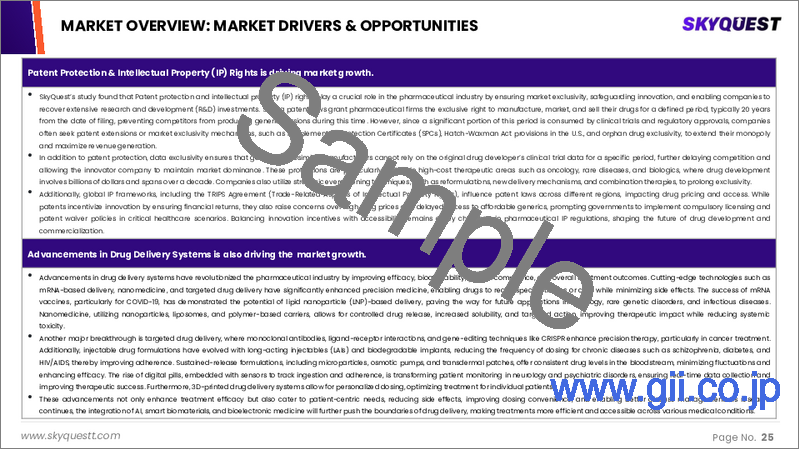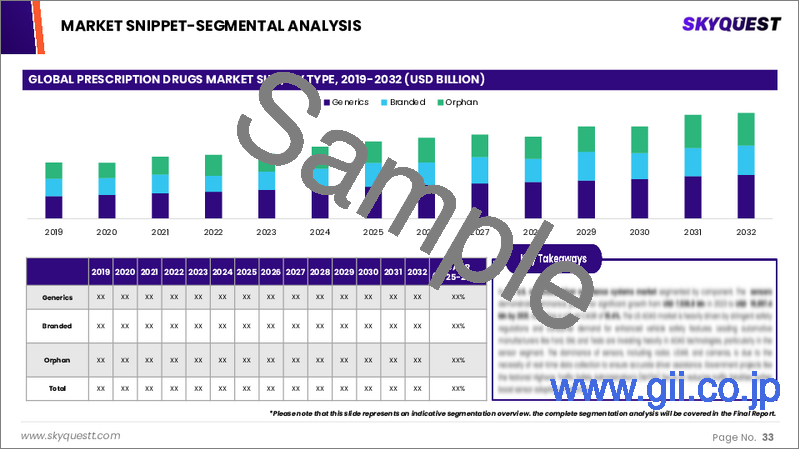|
|
市場調査レポート
商品コード
1630672
処方薬市場規模、シェア、成長分析、製品タイプ別、治療領域別、投与経路別、エンドユーザー別、流通チャネル別、地域別 - 産業予測、2025-2032年Prescription Drugs Market Size, Share, Growth Analysis, By Product Type (Generics, Orphan), By Therapy Area (Oncology, Immunology), By Route of Administration, By End-Users, By Distribution Channel, By Region - Industry Forecast 2025-2032 |
||||||
|
|||||||
| 処方薬市場規模、シェア、成長分析、製品タイプ別、治療領域別、投与経路別、エンドユーザー別、流通チャネル別、地域別 - 産業予測、2025-2032年 |
|
出版日: 2025年01月08日
発行: SkyQuest
ページ情報: 英文 157 Pages
納期: 3~5営業日
|
全表示
- 概要
- 目次
処方薬の世界市場規模は、2023年に1兆2,257億8,000万米ドルと評価され、2024年の1兆3,348億7,000万米ドルから2032年には2兆6,403億6,000万米ドルに成長し、予測期間中(2025~2032年)のCAGRは8.9%で成長する見通しです。
市販薬(OTC)は処方薬よりも効力が低く、誤用すると副作用を引き起こす可能性があります。そのため、これらの薬は医師の処方箋によってのみ入手でき、処方箋用紙や薬局の看板には「Rx」と記載されることがよくあります。世界の医薬品支出は、予測期間中に大幅な市場成長を牽引すると予想されるが、その主な理由は、特殊な医薬品のコスト増と、慢性疾患や希少疾患の治療の増加です。この動向は、特に北米で大きな市場シェアを占める高齢化によってさらに複雑化する一方、アジア太平洋地域は医療を必要とする膨大な人口を背景に急成長を遂げています。ヘルスケア・インフラ投資の強化は、市場機会をさらに拡大します。
目次
イントロダクション
- 調査の目的
- 調査範囲
- 定義
調査手法
- 情報調達
- 二次データと一次データの方法
- 市場規模予測
- 市場の前提条件と制限
エグゼクティブサマリー
- 世界市場の見通し
- 供給と需要の動向分析
- セグメント別機会分析
市場力学と見通し
- 市場概要
- 市場規模
- 市場力学
- 促進要因と機会
- 抑制要因と課題
- ポーターの分析
主な市場の考察
- 重要成功要因
- 競合の程度
- 主な投資機会
- 市場エコシステム
- 市場の魅力指数(2024年)
- PESTEL分析
- マクロ経済指標
- バリューチェーン分析
- 価格分析
- 技術の進歩
- 規制情勢
- ケーススタディ
処方薬市場規模:製品タイプ別
- 市場概要
- ジェネリック
- オーファン
- その他処方薬
処方薬市場規模:治療領域別
- 市場概要
- 腫瘍学
- 免疫学
- 眼科
- 呼吸器
- 皮膚科
- 消化器内科
- 泌尿器科
- 婦人科
- 内分泌学
- その他
処方薬市場規模:投与経路別
- 市場概要
- オーラル
- トピカル
- 非経口
- その他
処方薬市場規模:エンドユーザー別
- 市場概要
- 病院
- 専門クリニック
- ホームケア
- その他
処方薬市場規模:流通チャネル別
- 市場概要
- 病院薬局
- 小売薬局
- オンライン薬局
- その他
処方薬市場規模
- 北米
- 米国
- カナダ
- 欧州
- ドイツ
- スペイン
- フランス
- 英国
- イタリア
- その他欧州地域
- アジア太平洋地域
- 中国
- インド
- 日本
- 韓国
- その他アジア太平洋地域
- ラテンアメリカ
- ブラジル
- その他ラテンアメリカ地域
- 中東・アフリカ
- GCC諸国
- 南アフリカ
- その他中東・アフリカ
競合情報
- 上位5社の比較
- 主要企業の市場ポジショニング(2024年)
- 主な市場企業が採用した戦略
- 市場の最近の動向
- 企業の市場シェア分析(2024年)
- 主要企業の企業プロファイル
- 会社概要
- 製品ポートフォリオ分析
- セグメント別シェア分析
- 収益の前年比比較(2022-2024)
主要企業プロファイル
- Pfizer Inc.(United States)
- Johnson & Johnson(United States)
- Roche Holding AG(Switzerland)
- Merck & Co., Inc.(United States)
- AbbVie Inc.(United States)
- Novartis AG(Switzerland)
- Bristol-Myers Squibb Company(United States)
- Sanofi S.A.(France)
- AstraZeneca plc(United Kingdom)
- GlaxoSmithKline plc(GSK)(United Kingdom)
- Eli Lilly and Company(United States)
- Gilead Sciences, Inc.(United States)
- Amgen Inc.(United States)
- Bayer AG(Germany)
- Takeda Pharmaceutical Company Limited(Japan)
- Novo Nordisk A/S(Denmark)
- Merck KGaA(Germany)
- Biogen Inc.(United States)
- Teva Pharmaceutical Industries Ltd.(Israel)
結論と推奨事項
Global Prescription Drugs Market size was valued at USD 1225.78 billion in 2023 and is poised to grow from USD 1334.87 billion in 2024 to USD 2640.36 billion by 2032, growing at a CAGR of 8.9% during the forecast period (2025-2032).
The over-the-counter (OTC) treatments are less potent than prescription medications, leading to potential adverse effects if misused. Consequently, these medications can only be obtained through a doctor's prescription, often denoted by "Rx" on prescription pads and pharmacy signage. Global pharmaceutical spending is anticipated to drive significant market growth during the forecast period, primarily due to the increasing costs of specialized drugs and the rise in medical treatments for chronic and rare illnesses. This trend is compounded by an aging population, particularly in North America, which holds a substantial market share, while the Asia-Pacific region experiences rapid growth due to its vast population in need of care. Enhanced healthcare infrastructure investments further bolster market opportunities.
Top-down and bottom-up approaches were used to estimate and validate the size of the Global Prescription Drugs market and to estimate the size of various other dependent submarkets. The research methodology used to estimate the market size includes the following details: The key players in the market were identified through secondary research, and their market shares in the respective regions were determined through primary and secondary research. This entire procedure includes the study of the annual and financial reports of the top market players and extensive interviews for key insights from industry leaders such as CEOs, VPs, directors, and marketing executives. All percentage shares split, and breakdowns were determined using secondary sources and verified through Primary sources. All possible parameters that affect the markets covered in this research study have been accounted for, viewed in extensive detail, verified through primary research, and analyzed to get the final quantitative and qualitative data.
Global Prescription Drugs Market Segmental Analysis
Global Prescription Drugs Market is segmented by Product Type, Therapy Area, Route of Administration, End-Users, Distribution Channel and region. Based on Product Type, the market is segmented into Generics, Orphan and Other Prescription Drugs. Based on Therapy Area, the market is segmented into Oncology, Immunology, Ophthalmology, Respiratory, Dermatology, Gastroenterology, Urology, Gynaecology, Endocrinology and Others. Based on Route of Administration, the market is segmented into Oral, Topical, Parenteral and Others. Based on End-Users, the market is segmented into Hospitals, Specialty Clinics, Homecare and Others. Based on Distribution Channel, the market is segmented into Hospital Pharmacy, Retail Pharmacy, Online Pharmacy and Others. Based on region, the market is segmented into North America, Europe, Asia Pacific, Latin America and Middle East & Africa.
Driver of the Global Prescription Drugs Market
The global prescription drugs market is being significantly driven by the increasing introduction of novel products, particularly generic versions of essential medications in developed countries like the United States. These generic options are gaining traction because they often offer comparable efficacy to brand-name drugs at a fraction of the cost, making them more accessible for patients. This affordability plays a crucial role, especially for individuals who cannot afford high-priced medications, as well as those in emerging markets facing financial constraints. Such trends underscore the potential for enhanced clinical outcomes and are projected to propel market growth throughout the forecast period.
Restraints in the Global Prescription Drugs Market
The global prescription drugs market is facing significant restraints that impede its growth, primarily due to the high costs associated with many medications. As essential health issues like cancer and cardiovascular diseases rise, particularly in developing regions such as Africa, Latin America, and Asia, the affordability of new products remains a critical barrier. These exorbitant prices, often ranging from USD 100,000 to USD 500,000, limit access to treatment for a substantial number of patients, many of whom encounter financial strain as they seek these essential drugs. Consequently, the lack of widespread adoption of effective medications poses a challenge for market expansion.
Market Trends of the Global Prescription Drugs Market
The Global Prescription Drugs market is witnessing a significant trend characterized by heightened R&D investments from leading pharmaceutical companies aimed at developing innovative drugs. This surge is largely driven by the rising prevalence of chronic diseases worldwide, leading to increased patient demand for effective treatments to address unmet clinical needs. As these chronic disorders often require aggressive treatment strategies, pharmaceutical firms are intensifying their efforts in clinical trials to bring new therapies to market. Additionally, there is a notable shift towards developing medications for rare diseases, which further propels market growth as companies aim to fulfill niche yet critical healthcare needs.
Table of Contents
Introduction
- Objectives of the Study
- Scope of the Report
- Definitions
Research Methodology
- Information Procurement
- Secondary & Primary Data Methods
- Market Size Estimation
- Market Assumptions & Limitations
Executive Summary
- Global Market Outlook
- Supply & Demand Trend Analysis
- Segmental Opportunity Analysis
Market Dynamics & Outlook
- Market Overview
- Market Size
- Market Dynamics
- Drivers & Opportunities
- Restraints & Challenges
- Porters Analysis
- Competitive rivalry
- Threat of substitute
- Bargaining power of buyers
- Threat of new entrants
- Bargaining power of suppliers
Key Market Insights
- Key Success Factors
- Degree of Competition
- Top Investment Pockets
- Market Ecosystem
- Market Attractiveness Index, 2024
- PESTEL Analysis
- Macro-Economic Indicators
- Value Chain Analysis
- Pricing Analysis
- Technological Advancement
- Regulatory Landscape
- Case Studies
Global Prescription Drugs Market Size by Product Type & CAGR (2025-2032)
- Market Overview
- Generics
- Orphan
- Other Prescription Drugs
Global Prescription Drugs Market Size by Therapy Area & CAGR (2025-2032)
- Market Overview
- Oncology
- Immunology
- Ophthalmology
- Respiratory
- Dermatology
- Gastroenterology
- Urology
- Gynaecology
- Endocrinology
- Others
Global Prescription Drugs Market Size by Route of Administration & CAGR (2025-2032)
- Market Overview
- Oral
- Topical
- Parenteral
- Others
Global Prescription Drugs Market Size by End-Users & CAGR (2025-2032)
- Market Overview
- Hospitals
- Specialty Clinics
- Homecare
- Others
Global Prescription Drugs Market Size by Distribution Channel & CAGR (2025-2032)
- Market Overview
- Hospital Pharmacy
- Retail Pharmacy
- Online Pharmacy
- Others
Global Prescription Drugs Market Size & CAGR (2025-2032)
- North America (Product Type, Therapy Area, Route of Administration, End-Users, Distribution Channel)
- US
- Canada
- Europe (Product Type, Therapy Area, Route of Administration, End-Users, Distribution Channel)
- Germany
- Spain
- France
- UK
- Italy
- Rest of Europe
- Asia Pacific (Product Type, Therapy Area, Route of Administration, End-Users, Distribution Channel)
- China
- India
- Japan
- South Korea
- Rest of Asia-Pacific
- Latin America (Product Type, Therapy Area, Route of Administration, End-Users, Distribution Channel)
- Brazil
- Rest of Latin America
- Middle East & Africa (Product Type, Therapy Area, Route of Administration, End-Users, Distribution Channel)
- GCC Countries
- South Africa
- Rest of Middle East & Africa
Competitive Intelligence
- Top 5 Player Comparison
- Market Positioning of Key Players, 2024
- Strategies Adopted by Key Market Players
- Recent Developments in the Market
- Company Market Share Analysis, 2024
- Company Profiles of All Key Players
- Company Details
- Product Portfolio Analysis
- Company's Segmental Share Analysis
- Revenue Y-O-Y Comparison (2022-2024)
Key Company Profiles
- Pfizer Inc. (United States)
- Company Overview
- Business Segment Overview
- Financial Updates
- Key Developments
- Johnson & Johnson (United States)
- Company Overview
- Business Segment Overview
- Financial Updates
- Key Developments
- Roche Holding AG (Switzerland)
- Company Overview
- Business Segment Overview
- Financial Updates
- Key Developments
- Merck & Co., Inc. (United States)
- Company Overview
- Business Segment Overview
- Financial Updates
- Key Developments
- AbbVie Inc. (United States)
- Company Overview
- Business Segment Overview
- Financial Updates
- Key Developments
- Novartis AG (Switzerland)
- Company Overview
- Business Segment Overview
- Financial Updates
- Key Developments
- Bristol-Myers Squibb Company (United States)
- Company Overview
- Business Segment Overview
- Financial Updates
- Key Developments
- Sanofi S.A. (France)
- Company Overview
- Business Segment Overview
- Financial Updates
- Key Developments
- AstraZeneca plc (United Kingdom)
- Company Overview
- Business Segment Overview
- Financial Updates
- Key Developments
- GlaxoSmithKline plc (GSK) (United Kingdom)
- Company Overview
- Business Segment Overview
- Financial Updates
- Key Developments
- Eli Lilly and Company (United States)
- Company Overview
- Business Segment Overview
- Financial Updates
- Key Developments
- Gilead Sciences, Inc. (United States)
- Company Overview
- Business Segment Overview
- Financial Updates
- Key Developments
- Amgen Inc. (United States)
- Company Overview
- Business Segment Overview
- Financial Updates
- Key Developments
- Bayer AG (Germany)
- Company Overview
- Business Segment Overview
- Financial Updates
- Key Developments
- Takeda Pharmaceutical Company Limited (Japan)
- Company Overview
- Business Segment Overview
- Financial Updates
- Key Developments
- Novo Nordisk A/S (Denmark)
- Company Overview
- Business Segment Overview
- Financial Updates
- Key Developments
- Merck KGaA (Germany)
- Company Overview
- Business Segment Overview
- Financial Updates
- Key Developments
- Biogen Inc. (United States)
- Company Overview
- Business Segment Overview
- Financial Updates
- Key Developments
- Teva Pharmaceutical Industries Ltd. (Israel)
- Company Overview
- Business Segment Overview
- Financial Updates
- Key Developments





